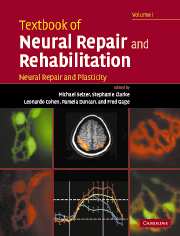Book contents
- Frontmatter
- Contents
- Contents (contents of Volume II)
- Preface
- Contributors (contributors of Volume I)
- Contributors (contributors of Volume II)
- Neural repair and rehabilitation: an introduction
- Section A Neural plasticity
- Section A1 Cellular and molecular mechanisms of neural plasticity
- Section A2 Functional plasticity in CNS system
- Section A3 Plasticity after injury to the CNS
- Section B1 Neural repair
- Section B2 Determinants of regeneration in the injured nervous system
- Section B3 Promotion of regeneration in the injured nervous system
- 25 Cell replacement in spinal cord injury
- 26 Dysfunction and recovery in demyelinated and dysmyelinated axons
- 27 Role of Schwann cells in peripheral nerve regeneration
- 28 Transplantation of Schwann cells and olfactory ensheathing cells to promote regeneration in the CNS
- 29 Trophic factor delivery by gene therapy
- 30 Assessment of sensorimotor function after spinal cord injury and repair
- Section B4 Translational research: application to human neural injury
- Index
28 - Transplantation of Schwann cells and olfactory ensheathing cells to promote regeneration in the CNS
from Section B3 - Promotion of regeneration in the injured nervous system
Published online by Cambridge University Press: 05 March 2012
- Frontmatter
- Contents
- Contents (contents of Volume II)
- Preface
- Contributors (contributors of Volume I)
- Contributors (contributors of Volume II)
- Neural repair and rehabilitation: an introduction
- Section A Neural plasticity
- Section A1 Cellular and molecular mechanisms of neural plasticity
- Section A2 Functional plasticity in CNS system
- Section A3 Plasticity after injury to the CNS
- Section B1 Neural repair
- Section B2 Determinants of regeneration in the injured nervous system
- Section B3 Promotion of regeneration in the injured nervous system
- 25 Cell replacement in spinal cord injury
- 26 Dysfunction and recovery in demyelinated and dysmyelinated axons
- 27 Role of Schwann cells in peripheral nerve regeneration
- 28 Transplantation of Schwann cells and olfactory ensheathing cells to promote regeneration in the CNS
- 29 Trophic factor delivery by gene therapy
- 30 Assessment of sensorimotor function after spinal cord injury and repair
- Section B4 Translational research: application to human neural injury
- Index
Summary
The goal of this chapter is to provide an overview of the efficacy of Schwann cell (SC) and olfactory ensheathing cell (OEC) transplantation to repair the central nervous system (CNS). A transplanted bridge of cells to span the site of injury is a promising strategy to provide a permissive scaffold for axonal growth (reviewed in Bunge, 2001; Geller and Fawcett, 2002). Both cell types have been shown to be effective; both cell types offer advantages. SCs may be easily extricated from peripheral nerve and placed into culture to generate far larger numbers than OECs; they effectively myelinate regenerated fibers or remyelinate denuded axons in vivo. Because they do not invade astrocyte territory, they are not as migratory as OECs and additional strategies are needed to lure the regenerated fibers from the SC implant, unlike OECs. OECs are less accessible and are not yet available in large numbers, but they have been demonstrated to be reparative, including improving functional outcome, in certain lesion paradigms. They normally occupy an area of the mammalian CNS that undergoes continuous nerve fiber growth throughout adult life. Repair of the spinal cord receives most attention in this chapter because the constraints on page length and reference number preclude a more inclusive review. SC and OEC transplantation have been compared earlier (Plant et al., 2001b).
Keywords
- Type
- Chapter
- Information
- Textbook of Neural Repair and Rehabilitation , pp. 513 - 531Publisher: Cambridge University PressPrint publication year: 2006
- 7
- Cited by



